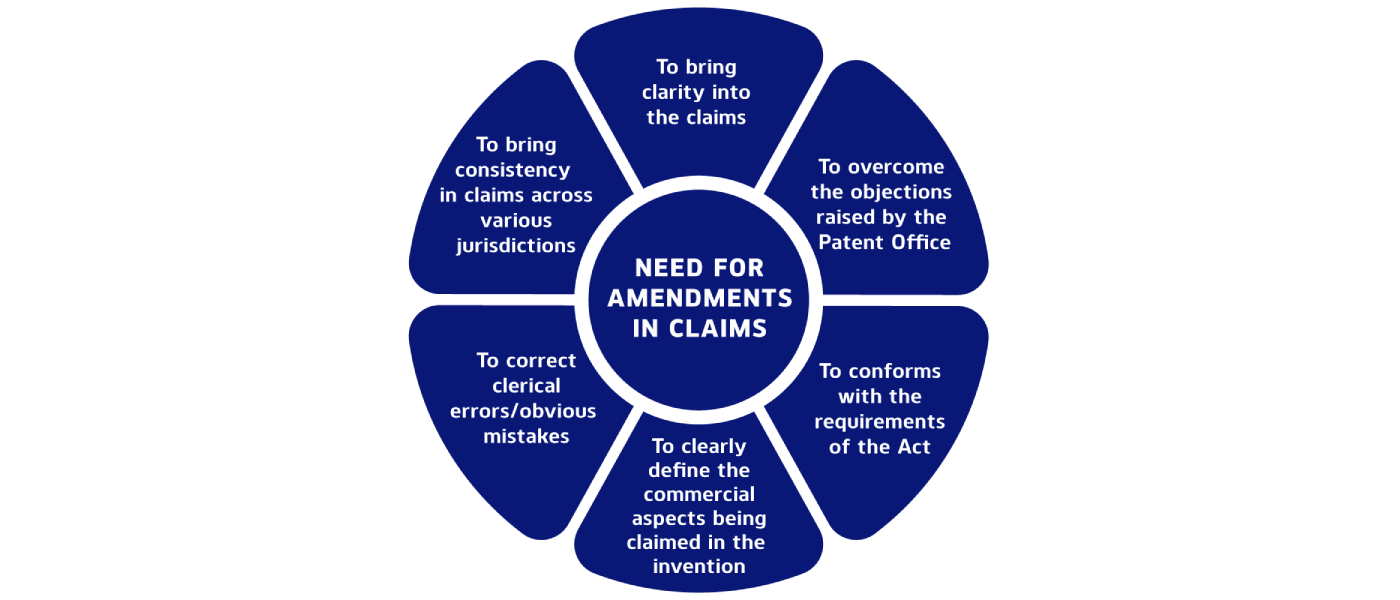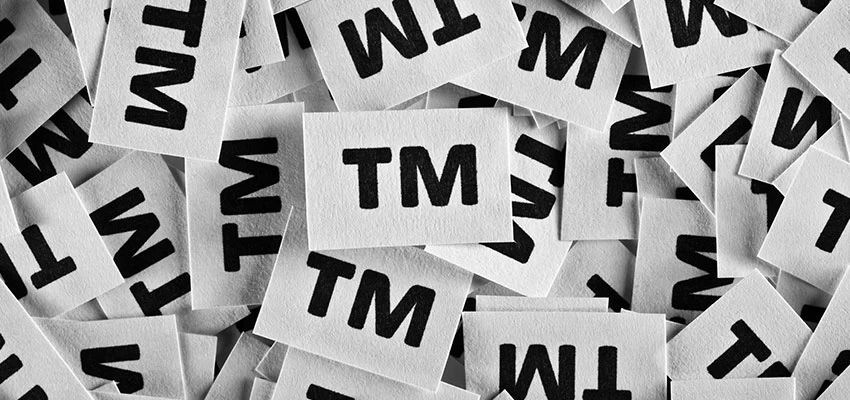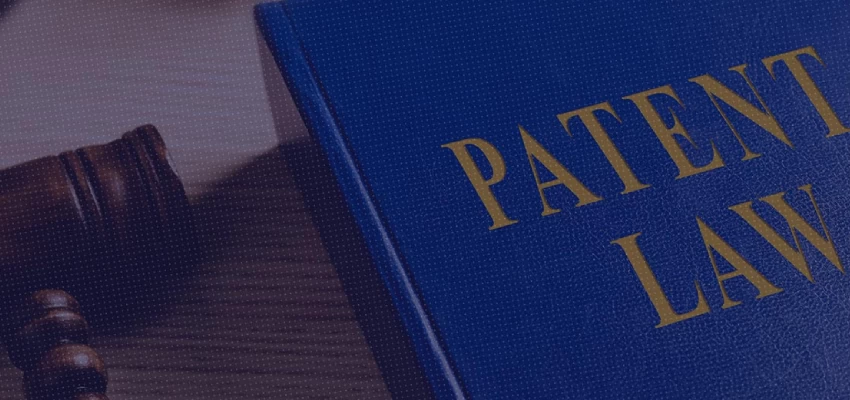Introduction
Amendments to a patent application form an essential element in demarcating the scope of inventions. In India, claim amendments are governed by Sections 57 to 59 of the Patents Act, 1970 (hereinafter referred to as the ‘Act’).
This article provides a comprehensive guide on the scope of claim amendments allowed in the Indian Patent regime. It focuses on the relevant aspects which must be kept in mind when applicants/patentees wish to file claim amendments. The article also highlights the trends at the Indian Patent Office (IPO) in examining the claim amendments.
Importance and requirements of amendments in claims
Claims form an important part of a patent specification as they determine the metes and bounds, or extent, of protection granted to an applicant/patentee. Section 10(4) of the Act states that ’Every complete specification shall: (c) end with a claim or claims defining the scope of the invention for which protection is claimed.’ Therefore, they are indispensable in laying out the scope of monopoly rights claimed.
An applicant/patentee can modify the scope of the protection being asserted by amending the claims. Claim amendments are widely acknowledged across several jurisdictions and have been part of the Indian patent system since 1911[1]. However, an applicant/patentee does not have an unbridled right of claim amendment. The assessment of whether an amended claim is allowable is done by comparing the proposed amendment with the claims before the amendment. The amendments must fall within the scope of the claims as they existed before the amendment and must not expand the scope of the invention. This proposition was laid down in the Ayyangar Committee Report, 1959[2] , and has since been implemented in the current Patent regime in India.
Since amendments delineate the scope of protection of the invention, it is important to understand the legal provisions underlining claim amendments.

Amendment provisions in the Indian Patent Act: Sections 57 - 59
Section 57 of the Act lays down the procedure of filing an amendment. An applicant/patentee can file an application for amendment using Form-13. An application for amendment must state the nature and reasons of the proposed amendment and contain support of the amendment from the pending or as filed claims. Section 58 of the Act deals with the amendment of the specification before the High Court.
Section 59 (1) of the Act lays down the types of amendments that are permissible under the Act:
| Ways of Amendment |
Scope of Amendment |
| Disclaimer |
Amendments that narrow down the invention by delimiting the claims.[3] |
| Correction |
Amendments made to correct clerical errors and mistakes |
| Explanation |
Amendments that do not change the scope of the invention and make the claims clear and unambiguous.[4] |
A pre-requisite of allowable amendments expounded clearly by Section 59(1) of the Act, as well as several legal precedents, is that the amendments must not claim any new subject matter which was not disclosed in the specification before the amendment. Further, the amendment must fall within the scope of the claims before the amendment and be supported in substance by the specification. These principles form the bedrock of allowable claim amendments and have been reiterated in several case laws.
Judgements to understand the trends of claim amendments
The Controller of Patents, Designs & Trademarks (hereinafter, ‘Controller’), in assessing whether the amendments fall within the scope of the specification before the amendment, must analyse the specification as a whole. Support for the amended claim may be found in the drawings in the original specification as well. The position was echoed by the erstwhile Hon’ble Intellectual Property Appellate Board (IPAB) in Prism Cement Ltd. v. The Controller of Patents and Designs[5]. In this case, the IPAB had to analyse whether changing the term ‘channel’ in the original claim to ‘open channel’ in an amendment broadened the scope of the claims. The IPAB held that perusal of the entire original specification shows that the amendment was already a ‘part and parcel of the original disclosure’ and did not broaden the scope of the claim.
Amendments that involve the addition of claims are analysed cautiously by the Controllers to ensure no new claim is being added. Addition of ‘independent’ claims is examined strictly and only allowed if the same falls within the scope of the as filed claims. Addition of ‘dependent’ claims is allowed if they add some further statement or restriction to the matter in the independent claim. The IPAB, in Tony Mon George – The Regents of the University of Michigan v. The Controller General of Patents, Designs & Trademarks & Anr[6] , elucidated upon this aspect. In this case, the IPAB addressed whether the insertion of dependent claims in an amendment is allowable. It accepted two out of three of such amendments by stating that if the dependent claims are not accepted, the principal claim would be left vague and non-definitive. Therefore, it cannot be said that the amendments were adding a ‘new’ subject matter, as they were defining the scope of the subject matter already present in the independent claim.
The issue of post-grant claim amendments was addressed by the Delhi High Court in AGC Flat Glass Europe SA v. Anand Mahajan and Ors [7]. The plaintiff, in this case, amended the claims during a patent infringement suit. The court allowed the addition of the phrase ‘a sensitizing material, typically tin’ in a claim listing the composition of an environment-friendly mirror, as it held that it was merely clarificatory in nature and did not extend the monopoly rights of the patentee. However, the Court noted that belated amendments may be a ground for refusal of the patent.[8] Therefore, patentees must be prudent in filing claim amendments after the grant of the patents.
Different stages of amendments in the claims
The information relevant for filing claim amendments at various stages of patent prosecution in India is provided below.
AMENDMENTS BEFORE THE GRANT OF PATENT APPLICATION
I. Amendments at the time of filing a patent application
Can claims be cancelled at the time of National Phase entry in India?
Yes. For the applications entering National Phase in India, deletion/cancellation of claims is the only amendment allowed, as per Rule 20(1) of the Patents Rules, 2003 (the ‘Rules’ hereinafter), to avail the benefit of reduction in claim fees. Such National Phase applications may include amendments which have already been filed under Article 19 or Article 34 of PCT. However, cancellation of claims must be considered carefully at this stage, since reinstating any cancelled subject matter at a later stage is difficult.
What type of claims can be cancelled at the time of National Phase entry in India?
Claims reciting statutorily non-patentable subject matter in India can be cancelled. If the claim recites a subject matter which falls under Sections 3 and 4 of the Act, they can be cancelled. A few examples of non-patentable subject matter in India are given below:
- Claims reciting a method of treatment of human beings or animals are not allowed in India under Section 3(i) of the Act.[9]
- Claims reciting a plant or an animal or any parts thereof and essentially biological processes for production or propagation of plants and animals are not allowed in India under Section 3(j) of the Act[10]. However, claims reciting microorganisms or microbial cells can be retained, if they have been prepared by substantial human intervention.
- Claims reciting a method of agriculture or horticulture are not allowed under Section 3(h) of the Act.[11]
- Claims to an invention relating to atomic energy are not allowed under Section 4 of the Act, read with Section 20(1) of the Atomic Energy Act, 1962.[12]
- Claims reciting ‘use’, application-type claims, and Swiss-type claims are not allowed in India under Section 2(1)(j) of the Act, since Section 2(1)(j) of the Act only allows product claims or process claims[13].
Can claims be merged/ added at the time of National Phase entry in India?
No. At the time of National Phase entry, any form of amendments other than deletion/cancellation of claims, is not allowed. These amendments can only be filed once the application has entered India. After the National Phase filing, a request for voluntary amendment of the claims can be made using Form-13 and submitting the prescribed fee for the same, in accordance with Rule 14 of the Rules.
Should claims be cancelled in a parent application before or after filing a divisional application?
A divisional application is carved from the claims present in the parent application. The principle ‘what is not claimed, stands disclaimed’, noted in the Indian Patent Office’s Manual of Practice and Procedures (hereinafter, ‘Manual’) is relevant in this regard[14]. When an applicant cancels a claim in the parent application before filing a divisional application, it implies that they have recanted their right over the claim. If these cancelled claims are recited in the divisional application, some Controllers may raise objections to the same, as they treat the cancelled claims as having been renounced by the applicant. Therefore, to overcome such objections, it is advisable that claims in a parent application only be cancelled after the divisional application[15] is filed.
II. Amendments at the time of request for examination
A request for examination can be filed either with amended claims made by way of voluntary amendment, or along with the as-filed claims.
If an applicant has retained the method of treatment claims or use claims at the time of National Phase entry and wishes to amend the said claims to recite a product claim to gain protection for their invention, would such an amendment be permissible?
An amendment that changes the scope of the claims from method of treatment claim or use claim to product claim is not allowed, even if the same has appropriate support in the specification. The rationale behind the same is that an amendment cannot change the scope of an invention that is essentially non-patentable under the Indian patent regime, to a patentable invention.
The Controller’s decision in patent application 4807/CHENP/2006, filed by Bristol-Myers Squibb throws light on this matter. The PCT application recited method of treatment claims, which are non-patentable in India. These were amended to Swiss-type claims at the time of national phase filing, and finally amended to recite composition claims. The application was rejected by the Controller, as firstly, amendments of a substantive nature are not allowed at the time of national filing, and secondly, as the amendments changed the scope of the invention.
III. Amendment at the time of active prosecution of the application
Active prosecution begins once the request for examination has been filed. Once the patent application has been carefully examined, an examination report is generated, listing the objections raised by the Controller. To overcome these objections, an amended set of claims can be filed along with the response to the examination report. If the Controller is not satisfied with the arguments, the IPO will offer a hearing to the applicant to address any pending objections. After the hearing, the applicant is required to submit the written response along with the amended claims, if any.
Can the applicant submit a main request along with auxiliary requests for claim amendments, similar to the European Patent Office (EPO)?
In the EPO, an applicant may submit a main request followed by one or more auxiliary requests with respect to claim amendments. This is done so that if the main requests are not allowed, alternatively, the auxiliary requests may be accepted.
In India, only one set of claims is submitted along with the response to the examination report, which is examined by the Controller. Subsequently, the Controller may grant the application or if there are any outstanding objections, the Controller may issue a Hearing Notice. After the hearing, the applicant can submit a final set of amended claims along with the written submission. There is no provision for submitting alternative, or auxiliary requests in India.
Can the cancelled claims be re-instated during the prosecution of the application?
If an applicant cancels any claims in an application, the IPO considers that the monopoly rights over the same are relinquished. Such cancelled claims are therefore deemed to be open for public use[16]. Reinstating them at a later stage may invite objections from the Controller. Therefore, where there is a possibility that claim(s) may be reintroduced later, it is advisable not to cancel such claim(s) in the first place. The Controller, in rare cases with acute possibility, may permit the re-insertion of cancelled claims if they meet the requirements of Section 59 of the Act.
AMENDMENTS AFTER THE GRANT OF THE APPLICATION
Amendments after the grant of the patent application are subject to various restrictions under Sections 57 and 59 of the Act.
Is there any provision to make amendments after the patent has been granted?
Yes. Section 57 of the Act allows a patentee to file an application for amendment after the grant of the patent. Further Rule 81(3) governs the procedure of post-grant claim amendments. The High Court of Delhi pronounced upon the maintainability of post-grant amendments in AGC Flat Glass Europe SA v. Anand Mahajan and Ors.[17] It allowed a post-grant amendment in this case as it was merely clarificatory/elaborative in nature and did not alter the scope of the invention. However, the Court made a cautionary statement noting that delays in filing claim amendments where the patentee is aware of the objection may lead to refusal of the patent. Therefore, it is advisable that amendments are filed either before the grant of the patent or promptly when the objection is become known to the patentee.
Will the doctrine of ‘lis pendens’ apply to the amendments in the claims?
Lis Pendens means ‘pending suit’ and is based on the maxim ‘Pendente lite nihil innovetur’, i.e., nothing new must be introduced while litigation or suit is pending.
As per the proviso of Section 57 of the Act, if any suit for infringement is pending before any Court, or any proceeding for revocation of the patent is pending before the High Court, the Controller shall not pass any order allowing or refusing the application for amendment.
Does the Patents Act empower the Controller for correcting clerical errors that do not lead to the inclusion of substantive amendments?
Section 78 of the Act authorizes the Controller to correct any clerical error, upon the request of any person interested or suo motu. It is important to note that a Controller may not make any amendments to the application in lieu of making corrections. Such power is restricted to making corrections that are not substantive, and do not materially alter the scope of the document. This position was reiterated by the Delhi High Court in Aia Engineering Ltd. v. Controller of Patents.[18]
Where a correction is proposed suo motu, the Controller shall notify the applicant/patentee, and any other person he deems to be a concerned party. Further, to prevent the expansion of the scope of the claims, where a substantial correction is requested, the proposed correction shall be published.
If the IPO allows the amendments, can a third party invalidate the claims?
The above refers to a situation where the amendments are not made by way of disclaimer, correction, or explanation, but meet the other requirements, i.e., incorporation of actual fact, claiming any matter which is disclosed in substance in the specification, and falling wholly within the scope of pre-amendment claims.
In this case, after the grant, the third party cannot challenge the granted claims by virtue of Section 59 of the Act. Rather, the third party needs to invalidate the claims by initiating a revocation proceeding under Section 64 of the Act.
AMENDMENTS AFTER REFUSAL OF THE APPLICATION
Is there any provision to amend the claims after the refusal of the patent application?
Upon refusal of a patent application, the applicant may file an appeal against the order at the High Court. Prior to the enactment of the Tribunals Reforms Act, 2021, such appeals were heard by the IPAB. The applicant should ideally file all their amendments before the Controller before the application is accepted or refused. In any appeal, it is not advisable to include any new matter that was not argued/presented at the lower echelon. Filing an amendment at this stage before IPO independent of the appeal, calls into question the conduct of the applicant.
Regardless, Section 58 of the Act authorises the High Court to allow amendments in claims or specification as it sees fit. If amendments proposed before the Patent Office were not considered, the same can be entertained by the High Court. Fresh amendments may be filed in a separate miscellaneous petition, filed along with the appeal. The Court has the discretion to accept the amendments, or to remand the matter to the Controller to consider it afresh.
Conclusion
Claim amendments form a crucial role in delineating the extent of monopoly rights that a patentee is granted in an invention. Sections 57 and 59 of the Act provide an important safeguard in reducing the scope of misuse and unjust expansion of claims. However, there must be a consistent interpretation of these provisions. Interpreting them restrictively and disallowing legitimate amendments shall unduly affect the interests of a genuine applicant/patentee, creating room for possible infringement of rights. With time and evolving jurisprudence, we hope that more decisions in the matter can help protect the rights of the applicant(s) effectively.
[The authors are Executive Director and Associate, respectively, in IPR Team at Lakshmikumaran & Sridharan Attorneys, New Delhi]
- [1] Section 17, Patents and Designs Act, 1911. [‘An applicant or a patentee may at any time, by request in writing left at the Department of Patents, Designs and Trade Marks and accompanied by the prescribed fee, seek leave to amend his application or specification, including drawings forming part thereof, by way of disclaimer, correction or explanation, stating the nature of, and the reasons for, the proposed amendment.’]
- [2] REPORT ON THE REVISION OF THE PATENTS LAW, Shri Justice N. Rajagopala Ayyangar (1959), ‘[w]here the invention which emerges as a result of an amendment is different from that which was the subject matter of the specification as originally accepted, such an amendment should not be permitted’ [available at: 1959-_Justice_N_R_Ayyangar_comm ittee_report.pdf].
- [3] AGC Flat Glass Europe SA v. Anand Mahajan and Ors., (2009) ILR 4 Delhi 256.
- [4] Prism Cement Ltd. v. The Controller of Patents and Designs, (IPAB) OA/7/2016/PT/MUM.
- [5] OA/7/2016/PT/MUM.
- [6] OA/48/2020/PT/DEL.
- [7] (2009) ILR 4 Delhi 256
- [8] ‘Are Belated Claim Amendments of Granted Patents Permitted?’, LAKSHMIKUMARAN & SRIDHARAN ATTORNEYS (available at Are Belated Claim Amendments of Granted Patents Permitted? | Lakshmikumaran & Sridharan Attorneys (lakshmisri.com)).
- [9] Section 3(i), Patents Act, 1970 [‘3. What are not inventions: …(i) any process for the medicinal, surgical, curative, prophylactic diagnostic, therapeutic or other treatment of human beings or any process for a similar treatment of animals to render them free of disease or to increase their economic value or that of their products.’].
- [10] Section 3(j), Patents Act, 1970 [‘3. What are not inventions: …(j) plants and animals in whole or any part thereof other than microorganisms but including seeds, varieties and species and essentially biological processes for production or propagation of plants and animals.’].
- [11] Section 3(h), Patents Act, 1970 [‘3. What are not inventions: …(h) a method of agriculture or horticulture’].
- [12] Section 20(1), Atomic Energy Act, 1962 [‘No patent shall be granted for inventions which, in the opinion of the Government of India, are useful for or relate to the production, control, use or disposal of atomic energy or the prospecting, mining, extraction, production, physical and chemical treatment, fabrication, enrichment, canning or use of any prescribed substance or radioactive substance or the ensuring of safety in atomic energy operations.’]
- [13] (2009)Section 2(1)(j), Patents Act, 1970. [‘‘invention’ means a new product or process involving an inventive step and capable of industrial application’].
- [14] (2009) Clause 05.03.15, MANUAL OF PATENT OFFICE PRACTICE AND PROCEDURES, 2019, The Office of Controller General of Patents, Designs and Trademarks [‘What is not claimed in the claims (including amended claims) stands disclaimed and is open to public use, even if the matter is disclosed in the description.’].
- [15] Divisional Applications in India – Evolving jurisprudence’, Lakshmikumaran & Sridharan ATTORNEYS (available at https://www.lakshmisri.com/insights/articles/divisional-applications-in-india-evolving-jurisprudence | Lakshmikumaran & Sridharan Attorneys (lakshmisri.com)
- [16] Clause 05.03.15, MANUAL OF PATENT OFFICE PRACTICE AND PROCEDURES, 2019, The Office of Controller General of Patents, Designs and Trademarks [‘What is not claimed in the claims (including amended claims) stands disclaimed and is open to public use, even if the matter is disclosed in the description.’].
- [17] (2009) ILR 4 Delhi 256.
- [18] 2007 (34) PTC 457 Del.












